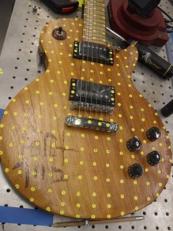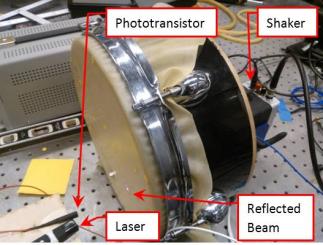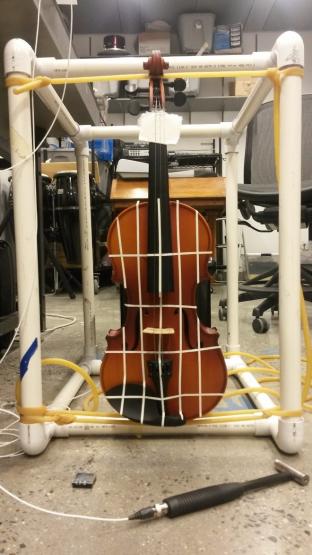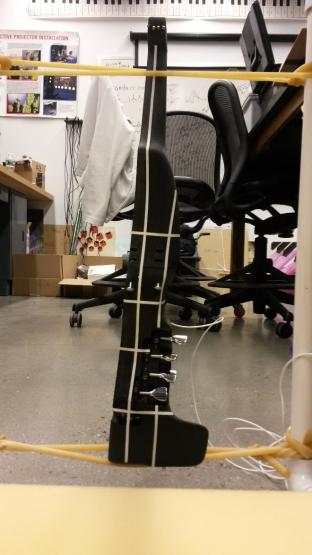Advanced Mechanical Vibrations (ME401)
Advanced Mechanical Vibration (ME401) is a graduate-level course that introduces students to the fields of structural dynamics and experimental modal analysis. Topics include:
- Combined experimental and analytical approach to mechanical vibration issues
- Characterization of the dynamic behavior of a structure in terms of modal parameters
- Digital data acquisition and signal processing
- Experimental modal analysis procedures and excitation techniques
- Hands-on experience with impact hammer and shaker data acquisition and analysis
Course Course Objectives:
- To review single-degree-of-freedom and multiple-degree-of-freedom vibration
- To teach how to characterize the dynamic behavior of a structure in terms of its modal parameters (e.g. natural frequencies, damping, and mode shapes)
- To introduce concepts of digital signal processing and important data acquisition considerations (e.g. sampling parameters, quantization, windows, etc.)
- To teach time vs. frequency domain analysis
- To teach how analytical and experimental dynamic models of a structure can be obtained and how these models can be used (e.g. troubleshooting, simulation/prediction, optimization, and diagnosis/monitoring)
- To introduce impact hammer and shaker excitation techniques and modal testing procedures
- To introduce modern vibration data acquisition software and hardware
Course Outcomes:
- Use of digital signal processing as a tool and understanding of important data acquisition considerations
- Ability to acquire and interpret Frequency Response Functions
- Ability to describe basic vibration data acquisition hardware and excitation techniques
- Basic proficiency in data acquisition and analysis software (e.g. LabVIEW, LMS Test.Lab) and an ability to navigate such engineering tools to learn new functionality and capabilities as needed
- Ability to approach real-world vibration problem and use modern vibration data acquisition and analysis tools
Examples of past student projects:
Development of Open-Source Vibration Visualization Program and Analysis of an Electric Guitar
David Tan (ME'14)
An electric guitar uses electromagnetic inductance to convert mechanical energy in the strings into electrical energy in the pickups, which is amplified and transmitted through a speaker. Ideally, each playable note lasts the same duration after the string is plucked, which is referred to as “sustain”. In practice, the sustain may vary from note to note and from fret to fret. This project tested the hypothesis that notes with poor sustain may be near guitar body resonant frequencies, resulting in dissipation of mechanical energy in the body instead of the pickups.
Using an impact hammer test, the natural frequencies of the guitar body were identified. A program was written using OpenFrameworks that analyzes the data collected and animates the deformations. One of the natural frequencies of the guitar is around 163Hz. The closest note, an E3, is at 165Hz, and can be played on the 7th fret of the 5th string, which is close to the point of maximum deflection of the mode shape. The note was found to have a lower sustain than the notes half a step above or below the E3. Further research is necessary to confirm the hypothesis. Below is a video with animation of the resonant frequencies (the blue dot indicates the impact location). Click here for technical report.

Development of Non-Invasive Vibration Testing Approach for Circular Membranes
Martin Lawless (ME'13)
Circular membranes play a role in musical instrument design, namely in drum heads and sound boards. The fundamental frequency depends on the material and size of the membrane, as well as the tension applied on the membrane, while the higher natural frequencies, or modes, depend on the circular geometry and the fundamental frequency.
Adding the mass of an accelerometer to a flexible membrane drastically changes the dynamic characteristics of the membrane. A novel approach to perform non-invasive modal analysis involves a phototransistor, in lieu of an accelerometer, that measures the changes in angle of a laser beam reflected off of a circular membrane in order to record frequency data. Shaker testing data collected from a rigid membrane using a laser transducer yielded similar frequency response results to data captured using a traditional accelerometer. Applying the novel experiment approach to an impact hammer test and analysis of a flexible, latex membrane revealed three modes at 21.24, 41.24, and 51.40 Hz, respectively. The higher modes deviate from theory of circular membranes, where the second and third modes have values of 1.59f1 and 2.14f1, respectively.
To visualize the mode shapes, a camera can record the vibration of the latex membrane with the aid of a digital stroboscope. A frequency generator drives a speaker, which in turn drives the membrane. The stroboscope tricks the eye to see the vibration of the membrane at a slower speed. The phototransistor testing set-up and stroboscope video of the first mode shape can be seen below.

Modal analysis of an acoustic violin and a 3D printed electric violin
Jacqueline Le (ME'16), ME401-IS
The F-F-Fiddle is an innovative, full-size, 3D-printed, electric violin. According to several sources, all violins, regardless of monetary value, have the same first five vibrational modes. This project is to determine whether or not the F-F-Fiddle has the same first five vibrational modes and whether or not it is comparable to an acoustic violin. In addition, the project explores how the equipment at the Cooper Union can be used to determine the modes of the violins. Click here for technical report.



